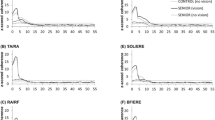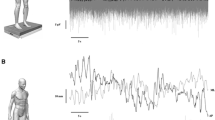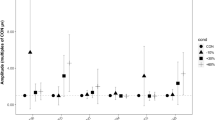Abstract
Posture and postural reactions to mechanical perturbations require the harmonic modulation of the activity of multiple muscles. This precision can become suboptimal in the presence of neuromuscular disorders and result in higher fall risk and associated levels of comorbidity. This study was designed to investigate neurophysiological principles related to the generation and distribution of inputs to skeletal muscles previously recognized as a synergistic group. Specifically, we investigated the current hypothesis that correlated neural inputs, as measured by intermuscular coherence, are the mechanism used by the central nervous system to coordinate the formation of postural muscle synergies. This hypothesis was investigated by analyzing the strength and distribution of correlated neural inputs to postural muscles during the execution of a quiet stance task. Nine participants, 4 females and 5 males, mean age 29.2 years old (±6.1 SD), performed the task of standing while holding a 5-kg barbell in front of their bodies at chest level. Subjects were asked to maintain a standing position for 10 s while the activity of three postural muscles was recorded by surface electrodes: soleus (SOL), biceps femoris (BF), and lumbar erector spinae (ERE). EMG–EMG coherence was estimated for three muscle pairs (SOL/BF, SOL/ERE, and BF/ERE). Our choice of studying these muscles was made based on the fact that they have been reported as components of a functional (synergistic) muscle group that emerges during the execution of bipedal stance. In addition, an isometric contraction can be easily induced in this muscle group by simply adding a weight to the body’s anterior aspect. The experimental condition elicited a significant increase in muscle activation levels for all three muscles (p < 0.01 for all muscles). EMG–EMG coherence analysis revealed significant coherence within two distinct frequency bands, 0–5 and 5–20 Hz. Significant coherence within the later frequency band was also found to be significantly uniformly distributed across the three muscle pairs. These findings are interpreted as corroborative with the idea of a hierarchic system of control where the controller may use the generation of common neural inputs to reduce the number of variables it manipulates.







Similar content being viewed by others
References
Amjad AM, Halliday DM, Rosenberg JR, Conway BA (1997) An extended difference of coherence test for comparing and combining several independent coherence estimates: theory and application to the study of motor units and physiological tremor. J Neurosci Methods 73:69–79
Bernstein NA (1967) The co-ordination and regulation of movements. Pergamon Press, Oxford
Boonstra TW, Daffertshofer A, van As E, van der Vlugt S, Beek PJ (2007) Bilateral motor unit synchronization is functionally organized. Exp Brain Res 178:79–88
Boonstra TJ, Roerdink M, Daffertshofer A, van Vugt B, van Werven G, Beek PJ (2008) Low-alcohol doses reduce common 10-to 15-Hz input to bilateral leg muscles during quiet standing. J Neurophysiol 100(Pt 4):2158–2164
Boonstra TW, Daffertshofer A, Roerdink M, Flipse I, Groenewoud K, Beek PJ (2009) Bilateral motor unit synchronization of leg muscles during a simple dynamic balance task. Eur J Neurosci 29(3):613–622
D’Avella A, Saltiel P, Bizzi E (2003) Combinations of muscle synergies in the construction of a natural motor behavior. Nat Neurosci 6:300–308
Danna-dos-Santos A, Slomka K, Latash ML, Zatsiorsky VM (2007) Muscle modes and synergies during voluntary body sway. Exp Brain Res 179:533–550
Danna-dos-Santos A, Degani AM, Latash ML (2008) Flexible muscle modes and synergies in challenging whole-body tasks. Exp Brain Res 189:171–187
Danna-dos-Santos A, Shapkova EY, Shapkova AL, Degani AM, Latash ML (2009) Postural control during upper body locomotor-like movements: similar synergies based on dissimilar muscle modes. Exp Brani Res 193:568–579
Danna-dos-Santos A, Poston B, Jesunathadas M, Bobich LR, Hamm T, Santello M (2010) Influence of fatigue on hand muscle coordination and EMG–EMG coherence during three-digit grasping. J Neurophysiol 104:3576–3587
De Luca CJ, Erim Z (2002) Common drive in motor units of a synergistic muscle pair. J Neurophysiol 87:2200–2204
Duarte M, Freitas SMSF (2010) Revision of posturography based on force plate for balance evaluation. Rev Bras Fisiot 14(3):183–192
Farmer SF (1998) Rhythmicity, synchronization and binding in human and primate motor systems. J Physiol 509(pt1):3–14
Farmer SF, Bremner FD, Halliday DM, Rosenberg JR, Stephens JA (1993) The frequency content of common synaptic inputs to motoneurones studied during voluntary isometric contraction in man. J Physiol 470:127–155
Gatev P, Thomas S, Kepple T, Hallet M (1999) Feedforward ankle strategy of balance during the quiet stance in adults. J Physiol 514(3):915–928
Gelfand IM, Latash ML (2002) On the problem of adequate language in biology. In: Latash ML (ed) Progress in motor control: structure-function relations in voluntary movement, vol 2. Human Kinetics, Urbana, pp 209–228
Gelfand IM, Tsetlin ML (1966) On mathematical modeling of the mechanisms of the central nervous system. In: Gelfan IM, Gurfinkel VS, Fomin SV, Tsetlin ML (eds) Models of the structural-functional organization organization of certain biological systems. Nauka, Moscow, pp 9–26
Grosse P, Brown P (2003) Acoustic startle evokes bilaterally synchronous oscillatory EMG activity in the healthy human. J Neurophysiol 90:1654–1661
Grosse P, Cassidy MJ, Brown P (2002) EEG–EMG, MEG–EMG and EMG–EMG frequency analysis: physiological principles and clinical applications. Clin Neurophysiol 113(10):1523
Halliday DM, Conway BA, Christensen LO, Hansen NL, Petersen NP, Nielsen JB (2003) Functional coupling of motor units is modulated during walking in human subjects. J Neurophysiol 89:960–968
Hansen NL, Conway BA, Halliday DM, Hansen S, Pyndt HS, Biering-Sorensen F, Nielsen JB (2005) Reduction of common synaptic drive to ankle dorsiflexor motoneurons during walking in patients with spinal cord lesion. J Neurophysiol 94:934–942
Ivanenko YP, Poppele RE, Lacquaniti F (2004) Five basic muscle activation patterns account for muscle activity during human locomotion. J Physiol 556:267–282
Ivanenko YP, Wright WG, Gurfinkel VS, Horak F, Cordo P (2006) Interaction of involuntary post-contraction activity with locomotor movements. Exp Brain Res 169:255–260
Johnston JA, Winges SA, Santello M (2005) Periodic modulation of motor-unit activity in extrinsic hand muscles during multi-digit grasping. J Neurophysiol 94:206–218
Karmen G, De Luca CJ (1992) Firing rate interactions among human orbicularis oris motor units. Int J Neurosci 64(1–4):167–175
Krishnamoorthy V, Goodman SR, Latash ML, Zatsiorsky VM (2003a) Muscle synergies during shifts of the center of pressure by standing persons: identification of muscle modes. Biol Cybern 89:152–161
Krishnamoorthy V, Latash ML, Scholz JP, Zatsiorsky VM (2003b) Muscle synergies during shifts of the center of pressure by standing persons. Exp Brain Res 152:281–292
Krishnamoorthy V, Latash ML, Scholz JP, Zatsiorsky VM (2004) Muscle modes during shifts of the center of pressure by standing persons: effects of instability and additional support. Exp Brain Res 157:18–31
Latash ML (2008) Synergy. Oxford University Press, USA, p 432
Latash ML, Scholz JP, Schoner G (2002) Motor control strategies revealed in the structure of motor variability. Exerc Sport Sci Rev 30:26–31
Latash ML, Danion F, Scholz JF, Zatsiorsky VM, Schoner G (2003) Approaches to analysis of handwriting as a task of coordinating a redundant motor system. Hum Mov Sci 22:153–157
Latash ML, Levin MF, Scholz JP, Schöner G (2010) Motor control theories and their applications. Medicine (Kaunas) 46(6):382–392
Maier MA, Hepp-Reymond MC (1995) EMG activation patterns during force production in precision grip. II. Muscular synergies in the spatial and temporal domain. Exp Brain Res 103:123–136
Maris E, Schoffelen JM, Fries P (2007) Nonparametric statistical testing of coherence differences. J Neurosci Methods 163:161–175
McAuley JH, Rothwell JC, Marsden CD (1997) Frequency peaks of tremor, muscle vibration and electromyographic activity at 10 Hz, 20 Hz and 40 Hz during human finger muscle contraction may reflect rhythmicities of central neural firing. Exp Brain Res 114:525–541
Mochizuki G, Semmler JG, Ivanova TD (2006) Low-frequency common modulation of soleus motor unit discharge is enhanced during postural control in humans. Exp Brain Res 175:584–595
Nashner LM, Horak FB (1986) Central programming of postural movements: adaptation to altered support-surface configurations. J Neurophysiol 55(6):1369–1381
Poston B, Danna-dos-Santos A, Jesunathadas M, Hamm TM, Santello M (2010) Force-independent distribution of correlated neural inputs to hand muscles during three-digit grasping. J Neurophysiol 104:1141–1154
Robert T, Zatsiorsky VM, Latash ML (2008) Multi-muscle synergies in an unusual postural task: quick shear force production. Exp Brain Res 187:237–253
Rosenberg JR, Amjad AM, Breeze P, Brillinger DR, Halliday DM (1989) The Fourier approach to the identification of functional coupling between neuronal spike trains. Prog Biophys Mol Biol 53:1–31
Santello M, Fuglevand AJ (2004) Role of across-muscle motor unit synchrony for the coordination of forces. Exp Brain Res 159:501–508
Scholz JP, Schöner G (1999) The uncontrolled manifold concept: identifying control variables for a functional task. Exp Brain Res 126:289–306
Scholz JP, Schöner G, Latash ML (2000) Identifying the control structure of multi-joint coordination during pistol shooting. Exp Brain Res 135(3):382–404
Scholz JP, Reisman D, Schöner G (2001) Effects of varying task constraints on solutions to joint coordination in a sit-to-stand task. Exp Brain Res 141(4):485–500
Semmler JG, Sale MV, Meyer FG, Nordstrom MA (2004) Motor-unit coherence and its relation with synchrony are influenced by training. J Neurophysiol 92:3320–3331
Sowman PF, Brinkworth ES, Turker KS (2006) Periodontal anaesthesia reduces common 8 Hz input to masseters during isometric biting. Exp Brain Res 169:326–337
Tresch MC, Cheung VC, D’Avella A (2006) Matrix factorization algorithms for the identification of muscle synergies: evaluation on simulated and experimental data sets. J Neurophysiol 95:2199–2212
Vallbo AB, Wessberg J (1993) Organization of motor output in slow finger movements in man. J Physiol 469:673–691
Wang Y, Zatsiorsky VM, Latash ML (2005) Muscle synergies involved in shifting center of pressure during making a first step. Exp Brain Res 167:196–210
Wang Y, Asaka T, Zatsiorsky VM, Latash ML (2006) Muscle synergies during voluntary body sway: combining across trials and within-a-trial analyses. Exp Brain Res 174:679–693
Weiss EJ, Flanders M (2004) Muscular and postural synergies of the human hand. J Neurophysiol 2:523–535
Winges SA, Kornatz KW, Santello M (2008) Common input to motor units of intrinsic and extrinsic hand muscles during two-digit object hold. J Neurophysiol 99:1119–1126
Author information
Authors and Affiliations
Corresponding author
Rights and permissions
About this article
Cite this article
Danna-Dos-Santos, A., Boonstra, T.W., Degani, A.M. et al. Multi-muscle control during bipedal stance: an EMG–EMG analysis approach. Exp Brain Res 232, 75–87 (2014). https://doi.org/10.1007/s00221-013-3721-z
Received:
Accepted:
Published:
Issue Date:
DOI: https://doi.org/10.1007/s00221-013-3721-z




